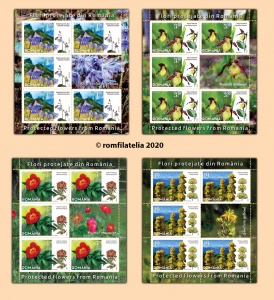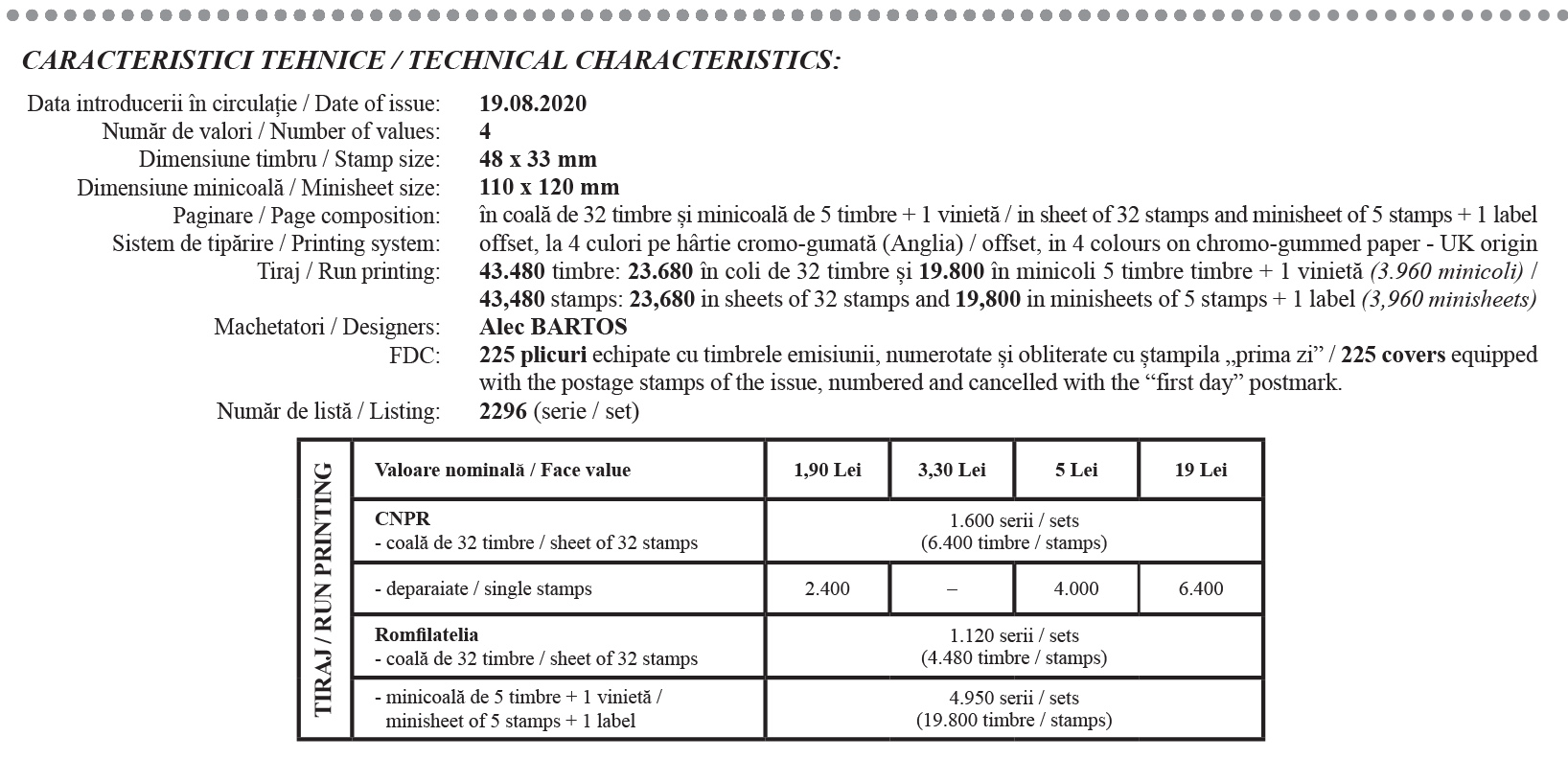 Wanting to support the efforts for protect the environment, part of the national wealth, which must be preserved for future generations, Romfilatelia introduces into circulation, on Wednesday, August 19th, 2020, the postage stamps issue Protected flowers from Romania.
Wanting to support the efforts for protect the environment, part of the national wealth, which must be preserved for future generations, Romfilatelia introduces into circulation, on Wednesday, August 19th, 2020, the postage stamps issue Protected flowers from Romania.
On the stamp with the face value of Lei 1.90 is illustrated Alpine snowbell or Blue moonwor (Soldanella oreodoxa). The Soldanella (Primulaceae) genus is characterized by the five purple petals joined in the shape of a funnel, with notched lobes, being endemic in the European alpine environment. The species of Soldanella oreodoxa is found in Baisoara Mountain, Scarita-Belioara reservation and Vladeasa Mountains, at about 1,000-1,400 m altitude. The plants are 8-22 cm high at the time of flowering. The rhizomes are ascending, 2-3 cm long. The stem is scapular, with 2-6 flowers. The leaves are petiolate, with 2-8 cm long petioles. The leaf blade has a cordate base and the edge is complete, slightly wavy. The corolla is blue-violet, with brown glandular hairs; the corolla tube is the same length or longer than the lacini. The pistil is 8-13 mm, longer than the corolla. The fruit is a brown capsule, 0.6-1.2 mm long, with 10-14 teeth. Soldanella oreodoxa prefers shady to moderately shady places, moderately moist to moderately damp, moderately acidic soils. Morphologically, the species is very similar to Soldanella major and Soldanella hungarica.
Lady’s-slipper orchid (Cypripedium calceolus), Orchidaceae family is represented on the stamp with the face value of Lei 3.30. It is a herbaceous, perennial plant, protected by law, geophyte, mesophyte, mesothermic, acid-neutrophilic, sciaphilous, found on calcareous soils, in shady forests in the counties of Maramures, Bistrita-Nasaud, Salaj, Cluj, Mures, Harghita, Covasna, Brasov, Sibiu, Alba, Hunedoara, Bihor, Caras-Severin, Mehedinti, Gorj, Arges, Buzau, Bacau, Neamt, Iasi, Suceava. It is also called blabornic, clonton, condurul-doamnei, floarea-cucului, gluga-ciobanului, papuc.
It has a repent rhizome, covered with scales, with numerous adventitious, relatively thick roots. The stem is cylindrical, pubescent, 15-70 cm high. The leaves are alternate, sessile, elliptical or ovate, with prominent, short-hairy strings. The flowers are zygomorphic, solitary, sometimes two at a time, with a pinna of the perigon in the shape of a cup, yellow, the others purple, brown, larger. Flowering takes place between May and June.
The beauty and fragrance of the flower led hikers to pick it up excessively, which led to its disappearance in some areas and considerable scarcity in many other parts.
On the stamp with the face value of Lei 5 is presented Romanian peony (Paeonia peregrina), Paeoniaceae family. Herbaceous, perennial, geophyte, xeromesophyte, mesothermic to moderately thermophilic plant, it’s found in meadows and forest edges in the south of Bucharest and in Dobrudja.
It is also called forest peony, ranjioara, rujie, rujioara, smardar and is declared a natural monument. It has tuberous, oblong-ellipsoidal root fibres and an erect, unbranched, glabrous stem, 50-80 cm high. The leaves and leaflets are deep and densely-sectioned, petiolate. The flowers are large, solitary, blood-like coloured. They have a calyx with 5-6 unequal, subfoliate sepals, and the corolla consists of 7-11 free, obovate-wedge-shaped, 5-7 cm long petals and the flowering takes place between May and June. It propagates by seeds and the separation of bushes.
Great yellow gentian (Gentiana lutea), Gentianaceae family is illustrated on the stamp with the face value of Lei 19. A herbaceous, perennial, medicinal plant, protected by law as a monument of nature, geophyte, mesophyte, microthermal, pH-amphitolerant, calciphilic, heliophilic, it is found on meadows in mountainous and alpine regions, rich in humus.
The plant is also called abrameasca, cahincea, duntura, fierea-pamantului, strigoaie, stegera, tintura and is cultivated for medicinal purposes.
It is resistant to very low winter temperatures, grows well on calcium-rich soils, on bright, sunny slopes. The stem of the plant is fistulous, cylindrical, unbranched, glabrous, leafy, 40-140 cm high.
The leaves are broad-ovate-elliptical, up to 30 cm long, up to 15 cm wide, with 5-7 prominent arched ribs. The flowers are yellow, large, long-pedicellate, arranged in corymb-shaped umbellae. Flowering takes place between June and August. The fruit is in the shape of a conical, unilocular capsule, 6 cm long, containing up to 100 broad-winged seeds on the edge.
The rhizome and root of the plant have therapeutic use in human and veterinary medicine. The plant is recommended in anorexia, convalescence, biliary dyskinesia, for the treatment of influenza, stimulation of liver and nervous system function. Propagation is achieved by separating the bushes and by seeds.
Romfilatelia thanks the “Dimitrie Brandza” Botanical Garden of the University of Bucharest and the “Alexandru Borza” Botanical Garden of the Babes-Bolyai University from Cluj-Napoca for the documentary support granted to the achievement of this postage stamps issue.



